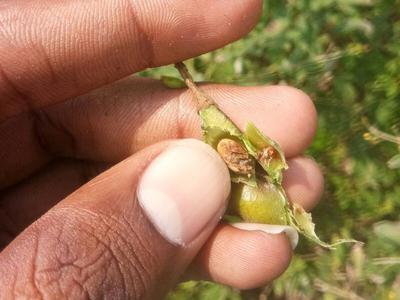Pod Fly
Melanagromyza obtusa
Insect
In a Nutshell
- Holes on pod walls.
- Damaged grains do not mature.
- Black flies.
- Creamy white maggots.
Can also be found in
Symptoms
The symptoms are not obvious until the fully-grown larvae form holes in the pod walls by chewing. This leaves a window through which the flies emerge after pupation in the pod. The pupae bore themselves into the grains, producing tunnels through which they exit as adults. The affected grains become shriveled and lose viability. Due to the larvae excreta, fungi may develop on infected plant parts. Damaged seeds are unfit for human consumption and are not viable for germination. Pinhead size holes can be found on dry pods. Seeds appear shriveled, striped and are partially eaten.
Recommendations

Organic Control
Conserve natural enemies of M. obtusa. Apply neem seed extract solution for four weeks (50 g/l water) or spray aqueous neem kernel extract fortnightly.

Chemical Control
Always consider an integrated approach with preventive measures together with biological treatments, if available. Spray Monocrotophos, Acephate or Lambda-cyhalothrin at flowering stage and then again after 10-15 days. To prevent resistance to specific insecticides, it is advised to alternate sprays in one season.
What caused it?
Damage is caused by the maggot of Melanagromyza obtusa, which feeds on the walls of developing grain. The adult flies (2-5 mm long) lay their eggs in the wall of immature pods of pigeon pea and other host plants. The hatched larvae are creamy white, while the pupae appear orange-brown. The maggot mines just under the epidermis of the seed without rupturing the seed coat, later it bores itself into the cotyledons. The final instar maggot leaves the seed and windows the pod prior to pupation.
Preventive Measures
- Use available resistant varieties for planting.
- Sow the crop early in the season to avoid the outbreak of Melanagromyza obtusa.
- Maintain good field sanitation and remove weeds regularly.
- Monitor your field for signs of the pest and use sticky traps to catch the adult flies.
- Intercropping with sorghum, maize and groundnut reduce the insect population.
- Practice crop rotation with non-host crops.
- Avoid growing a mixture of cultivars of differing duration in one area.



